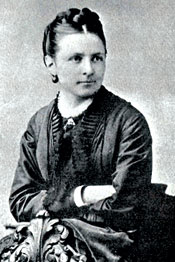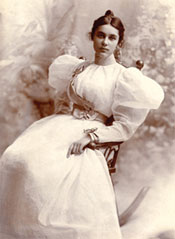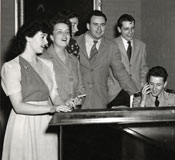Vassar 150: Access
As Vassar moves toward its sesquicentennial year, 2011, the Vassar Quarterly takes a look back at some of the significant moments in the life of the college. In this issue, we point to key signposts along the road to access.

Matthew Vassar presents the Board of Trustees of Vassar Female College with $408,000 in securities for the founding of the college and a deed for 200 acres.
1861

1864
After purchasing the art collection of trustee Elias L. Magoon, pictured, Vassar becomes the first college in the U.S. with a collection of art as an integral part of its curriculum.

Vassar Female College opens with 353 students, including one Civil War widow.
1865

1867
First Vassar Commencement held for four graduating students. By 1908, when this photo was taken, the number of graduates had grown considerably.

Founder Matthew Vassar dies while addressing a meeting of the Board of Trustees. He bequeathed $50,000 to aid "students of superior promise."
1868

1871
Associate Alumnae of Vassar College formed. Mary W. Whitney elected president.

Horse-car route from Poughkeepsie extended to the college. Today, a shuttle bus connects Vassar to downtown Poughkeepsie.
1872

1880
Telephone service established at Vassar.

Class president Princess Oyama (Stematz Yamakawa), becomes the first Japanese woman to receive an American college degree.
1882

1887
Florence Cushing 1874 becomes one of the first Vassar graduates and women to serve on Vassar's Board of Trustees. Cushing Hall was later dedicated in her name.

Educational circles are shocked when the race of Vassar's first African American graduate, Anita Hemmings, is revealed days before graduation.
1887

1892
Princeton professor Woodrow Wilson visits campus to lecture on democracy 20 years before becoming president.

Vassar’s student-run Athletic Association established to support new and existing Vassar sports. (Pictured: VC’s baseball team, the Resolutes.)
1895

1896
Lucy Maynard Salmon, History Department founder, creates the Vassar Alumnae Historical Association, which collects and preserves materials for the Vassar Library.

The Frederick Ferris Thompson Memorial Library is dedicated. It is the gift of Mary Clark Thompson, in honor of her late husband, a college trustee (1885-1899).
1905

1913
Inex Milholland 1909 leads 10,000 "suffragettes" down Fifth Avenue in New York City. The Times called the march women's "greatest spectacular triumph" in the pursuit of the ballot box.

Henry Noble MacCracken, Vassar’s longest serving president, appointed. He is credited with helping to increase Vassar’s involvement with the local community.
1915

1916
Professor of English Gertrude Buck establishes the Vassar Dramatic Workshop, making Vassar the first college in the U.S. to offer drama as a course.

The U.S. enters World War I. Around 200 graduates serve overseas. At home, Vassar "farmerettes" work as farmhands to replace labor claimed by military service.
1917

1920
A French tank is donated to the college in appreciation for the service of Vassar women (such as members of the Vassar Relief Unit) during and after the war.

Alumnae House is completed with a gift by sisters Blanche Ferry Hooker 1884 and Queene Ferry Coonley 1886.
1924

1925
Hallie Flanagan Davis, theatrical producer, director, and playwright, joins faculty. A year later, she becomes first women to receive a Guggenheim Award.

Wimpfheimer Nursery School, a laboratory school established on campus, provides Vassar students an opportunity for child study.
1926

1927
Edna St. Vincent Millay 1917 wins Pulitzer Prize for Poetry. Vassar students first take part in Junior Year Abroad.

Stock market crashes, ushering in the Great Depression. Raymond House residents save $100 a year on room and board by doing their own cooking and housekeeping.
1929

1931
Franklin Delano Roosevelt, governor of New York and trustee of the college (shown at left with President MacCracken), speaks at Commencement.

The Van Ingen Art Library, added onto Taylor Hall, is named for Vassar's first art professor, Henry Van Ingen.
1935

1938
Alumnae House opens an on-premises pub, attracting a steady stream of students and faculty members.

Pearl Harbor is attacked. U.S. enters World War II. Back home, Vassar students practice first aid, just in case.
1941

1946
Sarah Gibson Blanding inaugurated as Vassar's sixth and first women president (she served through 1964).

Vassar admits 100 veterans of the war. Several women's college temporarily opened their doors to men–such a large number had returned seeking education.
1946

1949
Field work office established. Here, a Vassar student works in a hospital play program.

Paintings by Picasso exhibited in Taylor Hall.
1951

1960
More than 100 Vassar students picket the local Woolworth's to protest lunch-counter segregation in the chain's southern stores.

Vassar celebrates its centennial year with an international conference on world problems and their implications for education.
1961

1969
Charter amended to welcome male students. After a takeover of Main Building by students, Black Studies becomes an integral part of the Vassar curriculum.

Co-ed housing introduced.
1971

1972
Vassar Gay Liberation Front holds first organizational meeting, three years after the Stonewall riots in Greenwich Village.

The Hallie Flanagan Davis Powerhouse Theater established to support emerging and established artists in the development of new works in theater and film.
1985

1993
The Frances Lehman Loeb Art Center, founded in 1864 as the Vassar College Art Gallery, opens a 36,000 sq. ft. facility near the Main Gate.

The ALANA Center, originally opened as the Intercultural Center in 1976, is renamed to reflect the students it serves--those of African, Latina/o, Asian, and Native American descent. Its location, the renovated “Coal Bin” Building, was dedicated in 1993.
1998

2007
Vassar returns to “need-blind” admission policy.

Vassar College announces participation in the Yellow Ribbon Program and offers discounted tuition to student veterans.
2009
Photo Credits: Special Collections,
Vassar College Libraries
Have comments about this article?
Email vq@vassar.edu
